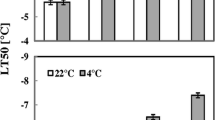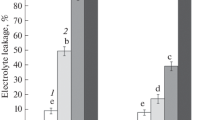Abstract
Freezing often results in a significant loss of sugarcane production. An investigation was conducted in two sugarcane cultivars, GT28 (Guitang 28, cold tolerant) and YL6 (Yuanlin 6, cold sensitive) to understand the cold tolerance mechanisms. The plants at early ripening stage, 245 days after planting, were exposed to cold stress (0 °C) for 0, 2, 4, and 6 days. The changes in chloroplast structure, microtubule, and physiological parameters under cold stress were determined. The morphology and chloroplast ultrastructure of the cultivar GT28 were observed normal while those of the cultivar YL6 was severely damaged and accumulation of starch grains in chloroplasts was evident under cold stress. At the beginning of cold stress, the microtubules in the cultivar GT28 was more obviously depolymerized than those in the cultivar YL6. With extended cold stress, the microtubules in the cultivar YL6 decreased noticeably and the chloroplast membrane became indistinct, while the microtubule fluorescence in the cultivar GT28 was intensified, indicating that the structure of microtubules was reorganized. Consequently, the cultivar GT28 showed a greater photosynthetic activity than YL6 under cold stress. The cold tolerance of the cultivar GT28 appeared to be related to the integrity of chloroplast structure, the stability of microtubule structure, and balanced physiological metabolisms. These results revealed that more stable chloroplast structure and microtubule structure under cold stress are the important physiological foundation of cold-tolerant sugarcane cultivars.





Similar content being viewed by others
References
Åström, H., I. Virtanen, and M. Raudaskoski. 1991. Cold-stability in the pollen tube cytoskeleton. Protoplasma 160 (2): 99–107.
Chen, N.W., R.Z. Yang, and C.W. Wu. 1996. Studies on the technique of identification for freeze resistance in sugarcane. Sugarcane & Canesugar 4: 1–9.
Chen, S.Y. 1991. Injury of membrane lipid peroxidation to plant cell. Plant Physiology Communications 27 (2): 84–90.
Du, Y.C., A. Nose, and K. Wasano. 1999. Effects of chilling temperature on photosynthetic rates, photosynthetic enzyme activities and metabolite levels in leaves of three sugarcane species. Plant, Cell and Environment 22: 317–324.
Figueroa, F.L., R. Conde-Alvarez, and I. Gómez. 2003. Relations between electron transport rates determined by pulse amplitude modulated chlorophyll fluorescence and oxygen evolution in macroalgae under different light conditions. Photosynthesis Research 75 (3): 259–275.
Georgieva, K., and H.K. Lichtenthaler. 2006. Photosynthetic response of different pea cultivars to low and high temperature treatments. Photosynthetica 44 (4): 569–578.
Guo, Z., W. Ou, S. Lu, and Q. Zhong. 2006. Differential responses of antioxidative system to chilling and drought in four rice cultivars differring in sensitivity. Plant Physiol & Biochemistry 44 (11–12): 828–836.
Huang, X., M.H. Chen, L.T. Yang, Y.L. Li, and J.M. Wu. 2015. Effects of exogenous abscisic acid on cell membrane and endogenous hormone contents in leaves of sugarcane seedlings under cold stress. Sugar Tech 17 (1): 59–64.
Jian, L.C., L.H. Sun, and Z.P. Lin. 1989. Studies on microtubule cold stability in relation to plant cold hardiness. Acta Botanica Sinica 31 (10): 737–741.
Jiang, M., and J. Zhang. 2001. Effect of abscisic acid on active oxygen species, antioxidative defense system and oxidative damage in leaves of maize seedlings. Plant and Cell Physiology 42 (11): 1265–1273.
Kalisz, A., S. Cebula, E. Kunicki, J. Gil, A. Sekara, and A. Grabowska. 2014. Effect of chilling stress before transplanting on morphological parameters of broccoli heads. Acta Scientiarum Polonorum Hortorum cultus 13 (1): 129–139.
Kimball, S.L., and F.B. Salisbury. 1973. Ultrastructural changes of plants exposed to low temperatures. American Journal of Botany 60 (10): 1028–1033.
Kratsch, H.A., and R.R. Wise. 2000. The ultrastructure of chilling stress. Plant, Cell and Environment 23 (4): 337–350.
Kutík, J., D. Holá, M. Kočová, O. Rothová, D. Haisel, N. Wilhelmová, and I. Tichá. 2004. Ultrastructure and dimensions of chloroplasts in leaves of three maizes (Zea mays L.) inbred lines and their F1 hybrids grown under moderate chilling stress. Photosynthetica 42 (3): 447–455.
Li, J.W., W. Loescher, D. Wei, D.L. Wei, H.Y. Shu, and H.L. Shao. 2009. Heat acclimation induced acquired heat tolerance and cross adaptation in different grape cultivars: Relationships to photosynthetic energy partitioning. Functional Plant Biology 36 (6): 516–526.
Li, Y.R., F.X. Fang, J.M. Wu, X. Li, R.H. Zhang, X.H. Liu, H. He, R.Z. Yang, L.T. Yang, G.L. Chen, S.Q. Su, J.L. Xie, X.Y. Liu, W.H. Huang, W.X. Duan, W.Z. He, and M. Wang. 2011. Survey of frost and cold damage on sugarcane production in Guangxi in 2010/2011 milling season and countermeasures. Journal of Southern Agriculture 42 (1): 37–42.
Lichtenthaler, H.K., and A.R. Welburn. 1983. Determinations of total carotenoids and chlorophylls a and b of leaf extracts in different solvents. Biochemical Society Transactions 11 (5): 591–592.
Lu, S.Y., X.H. Wang, and Z.F. Guo. 2013. Differential responses to chilling in Stylosanthes guianensis (Aublet) Sw. and its mutants. Agronomy Journal 105 (2): 377–382.
Lütz, C. 2010. Cell physiology of plants growing in cold environments. Protoplasma 244 (1–4): 53–73.
Marian, C.O., S.L. Krebs, and R. Arora. 2004. Dehydrin variability among rhododendron species: A 25 kDa dehydrin is conserved and associated with cold acclimation across diverse species. New Phytologist 161 (3): 773–780.
Mustárdy, L., and G. Garab. 2003. A three-dimensional model—Where things fall into place. Trends Plant Science 8 (3): 117–122.
Nick, P. 2008. Microtubules as sensors for abiotic stimuli. Plant microtubules In: Plant cell monographs: Plant microtubules, ed. Nick P, vol. 11(24), 175–203. Berlin: Springer.
Renaut, J., L. Hoffmann, and J.F. Hausman. 2005. Biochemical and physiological mechanisms related to cold acclimation and enhanced freezing tolerance in poplar plantlets. Physiologia Plantarum 125 (1): 82–94.
Salaj, J., and J. Hudák. 1999. Effect of low temperatures on the structure of plant cells. In Handbook of plant and crop stress, 2nd ed, ed. M. Pessarakli, 441–464. New York: Marcel Dekker, CRC Press.
Sangwan, V., I. Foulds, J. Singh, and R.S. Dhindsa. 2001. Cold-activation of Brassica napus BN115 promoter is mediated by structural changes in membranes and cytoskeleton, and requires Ca2+ influx. Plant Journal 27 (7): 1–12.
Saropulos, A.S., and D.S.H. Drennan. 2007. Ultrastructural alterations in mesophyll and bundle sheath chloroplasts of two maize cultivars in response to chilling at high irradiance. Biologia Plantarum 51 (4): 690–698.
Singh, T.N., L.G. Paleg, and D. Aspinall. 1973. Stress metabolism I. Nitrogen metabolism and growth in the barley plant during water stress. Australian Journal of Biological Sciences 26 (1): 45–56.
Soufia, S., G. D’Urso, C. Pizza, S. Rezgui, T. Bettaieb, and P. Montoro. 2016. Steviol glycosides targeted analysis in leaves of Stevia rebaudiana (Bertoni) from plants cultivated under chilling stress conditions. Food Chemistry 190: 572–580.
Tai, P.Y.P., and R.S. Lentini. 1998. Freeze damage of Florida sugarcane. In Sugarcane handbook, ed. D.L. Anderson. Gainesville: Florida Cooperative Extension.
Xu, P.L., Y.K. Guo, J.G. Bai, L. Shang, and X.J. Wang. 2008. Effects of longterm chilling on ultrastructure and antioxidant activity in leaves of two cucumber cultivars under low light. Physiologia Plantarum 132 (4): 467–478.
Yang, R.Z. 1999. A preliminary analysis on quality deterioration of several sugarcane varieties under natural frozen injury. Sugarcane 6 (2): 1–5.
Zeng, Z. Z., J. Wei, R. H. Wei, and X. Q. Zhu. 2008. Investigation of frost bitten sugarcane in Liujiang County. In: Proceedings of annual meeting of Guangxi Society of Sugarcane Technologists, 189–192.
Zhang, B.Q., L.T. Yang, and Y.R. Li. 2015. Physiological and biochemical characteristics related to cold resistance in sugarcane. Sugar Tech 17 (1): 49–58.
Zhang, S., H. Jiang, S. Peng, H. Korpelainen, and C. Li. 2011. Sex-related differences in morphological, physiological, and ultrastructural responses of Populus cathayana to chilling. Journal of Experimental Botany 62 (2): 675–686.
Zhang, X.C., Z.G. Li, S.L. Li, L. Lin, L.T. Yang, and Y.R. Li. 2008. Cryosectioning method for the observation of microtubule cytoskeleton in plant cells. Guihaia 28 (2): 164–166.
Zheng, G.H., D.M. Pan, X.Q. Niu, H.W. Wu, and L.B. Zhang. 2014. Changes in cell Ca2+ distribution in loquat leaves and its effects on cold tolerance. Korean Journal of Horticultural Science & Technology 32(5): 607–613.
Acknowledgements
This work was supported by the Grants from National Natural Science Foundation of China (31460373), Guangxi Natural Science Foundation projects (2011GXNSFA018067), State key laboratory for conservation and utilization of subcropical Agro-bioresources (SB1003); 863 Program Project (2013AA102604), and International Scientific Cooperation Program Projects (2013DFA31600), Guangxi R & D Research Program Projects (Gui Ke Gong1222014-2B and 1222009, Gui Ke He 13999002, Gui Ke He 1347004-2).
Author information
Authors and Affiliations
Corresponding authors
Ethics declarations
Conflict of interest
The authors declare that they have no conflict of interest.
Rights and permissions
About this article
Cite this article
Li, SL., Li, ZG., Yang, LT. et al. Differential Effects of Cold Stress on Chloroplasts Structures and Photosynthetic Characteristics in Cold-Sensitive and Cold-Tolerant Cultivars of Sugarcane. Sugar Tech 20, 11–20 (2018). https://doi.org/10.1007/s12355-017-0527-5
Received:
Accepted:
Published:
Issue Date:
DOI: https://doi.org/10.1007/s12355-017-0527-5




